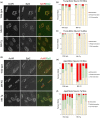SIRT1 deacetylase in aging-induced neuromuscular degeneration and amyotrophic lateral sclerosis
- PMID: 30295421
- PMCID: PMC6260920
- DOI: 10.1111/acel.12839
SIRT1 deacetylase in aging-induced neuromuscular degeneration and amyotrophic lateral sclerosis
Abstract
SIRT1 is an NAD+ -dependent deacetylase that functions in a variety of cells and tissues to mitigate age-associated diseases. However, it remains unknown if SIRT1 also acts to prevent pathological changes that accrue in motor neurons during aging and amyotrophic lateral sclerosis (ALS). In this study, we show that SIRT1 expression decreases in the spinal cord of wild-type mice during normal aging. Using mouse models either overexpressing or lacking SIRT1 in motor neurons, we found that SIRT1 slows age-related degeneration of motor neurons' presynaptic sites at neuromuscular junctions (NMJs). Transcriptional analysis of spinal cord shows an overlap of greater than 90% when comparing alterations during normal aging with changes during ALS, revealing a substantial upregulation in immune and inflammatory response genes and a downregulation of synaptic transcripts. In addition, overexpressing SIRT1 in motor neurons delays progression to end-stage disease in high copy SOD1G93A mice. Thus, our findings suggest that there are parallels between ALS and aging, and interventions to impede aging may also slow the progression of this devastating disease.
Keywords: NAD; SIRT1; aging; amyotrophic lateral sclerosis; neurodegenerative disease; neuromuscular junction.
© 2018 The Authors. Aging Cell published by the Anatomical Society and John Wiley & Sons Ltd.
Figures




References
-
- Braunstein, M. , Rose, A. B. , Holmes, S. J. , Allis, C. D. , & Broach, J. R. (1993). Transcriptional silencing in yeast is associated with reduced histone acetylation. Genes & Development, 7, 592–604. - PubMed
-
- Brunet, A. (2004). Stress‐dependent regulation of FOXO transcription factors by the SIRT1 deacetylase. Science, 303, 2011–2015. - PubMed
MeSH terms
Substances
Grants and funding
LinkOut - more resources
Full Text Sources
Medical
Molecular Biology Databases
Miscellaneous

